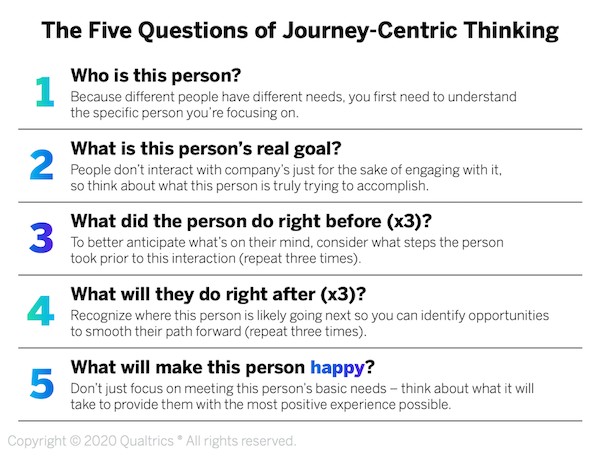Journey mapping has become a popular Experience Management (XM) tool. When used correctly, journey maps provide a valuable lens into how someone (e.g., customer, employee, partner) views their experiences with an organization. This holistic perspective, which cuts across departments and functions, helps an organization to design and deliver experiences that better address people’s true needs.
While journey mapping is valuable, it’s just not practical – or even possible – to create a detailed journey map for every potential customer, employee, or partner journey. So how can you get the benefits of a journey map without actually having to do all the work? By adopting what XM Institute calls Journey-Centric Thinking (what we used to call Customer Journey Thinking). This simple exercise will embed a broader, journey-level perspective into people’s day-to-day decisions and behaviors, encouraging them to proactively think about and support people’s true goals for interacting with the organization.
The process is simple. Every time someone is making a decision that will affect someone else’s experience, teach them to ask and answer these five questions:

1) Who is this person?
Journey-Centric Thinking begins with recognizing that different people have different needs, desires, and expectations when engaging with an organization. A new employee will likely need more hand-holding during the performance review process than his more tenured colleagues. A college student may be willing to extensively explore self-help options to solve a problem, whereas an older customer may want to reach a human agent right away. So before you can start thinking about someone’s specific journey, you first need to understand who exactly this person is. One particularly valuable tool for developing this understanding is customer and employee personas. Personas ensure that everyone within the organization shares a common understanding of who its target audiences are and how they are likely to feel and behave as they engage with the brand.
2) What is this person’s real goal?
People don’t interact with an organization simply for the joy of engaging with it. They interact with an organization because they are trying to achieve some broader, personal goal, and the path of reaching that goal just happens to intersect with the business somewhere along the way. For example, a mom booking flights and hotels through an online travel agency isn’t trying to do business with the company – she’s trying to plan a memorable family vacation. An active business traveler, meanwhile, is trying to meet her clients and advance her career. They’re going through the same experience but looking to accomplish two completely different objectives. So before you can determine what makes for a great experience – like cheaper fares or more flexibility – you first need to understand what higher-level goal this person is looking to accomplish.
3) What did the person do right before (x3)?
Next, because every interaction with an organization is just one step on a longer journey, you then need to understand what someone is likely to have done prior to this engagement – what steps have they already completed? What avenues have they already explored? What type of emotions or attitudes are they perhaps bringing with them from these previous experiences? Often, these prior interactions will include people and brands outside your organization. For example, if a candidate is applying for a position with your firm, he’s probably researched the company, discussed the job with friends and family, and explored similar roles at other organizations. Once you’ve answered the question of what the person likely did right before, ask and answer it at least two more times.
4) What will they do right after (x3)?
Interacting with your organization is almost never going to be the final step on someone’s journey. But you can help them reach their ultimate objective more easily by considering what they are likely to do right after they engage with you. Again, these subsequent interactions may include people and brands outside your organization. For instance, after a customer files an insurance claim, she might then have to call around to different auto repair shops to make an appointment and go online to book a rental car. Thinking about this question will help you recognize where there are opportunities to help smooth the person’s path forward, like proactively providing a list of repair shops in the area or pointing them to low-cost car rentals. After you’ve answered the question of what the person will likely do right after, ask and answer it at least two more times.
5) What will make this person happy?
Rather than aiming to simply satisfy people’s basic needs, think about what it will take to create the most positive experience possible for this individual given what you know about who they are and what journey they are on. “Happy” here is a proxy for whichever emotion your company is trying to evoke during this particular interaction. For example, an organization may want job candidates to feel respected and energized during the interview process, whereas after taking a training course, it may want them to feel confident in their new skills and cared for by the company. This focus on emotional states will help employees stay mindful of people’s true needs and help build a more empathetic organizational culture.
The five questions of Journey-Centric Thinking embed a journey mindset across an organization by prompting employees and leaders to actively consider why someone is interacting with the organization and how the interaction fits within their broader objectives and activities.
The bottom line: While journey maps are valuable, Journey-Centric Thinking is transformational.
Isabelle Zdatny, CCXP, is an XM Catalyst with the Qualtrics XM Institute





